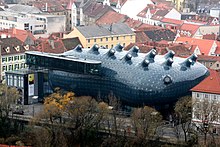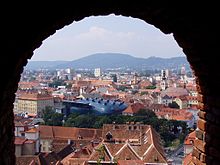
Graz is the capital city of the Austrian province of Styria and the second-largest city in Austria, after Vienna. As of 1 January 2021, Graz had a population of 331,562. In 2018, the population of the Graz larger urban zone (LUZ) stood at 652,654, based on principal-residence status. Graz is known as a college and university city, with four colleges and four universities. Combined, the city is home to more than 60,000 students. Its historic centre (Altstadt) is one of the best-preserved city centres in Central Europe.

Peter Weibel was an Austrian post-conceptual artist, curator, and new media theoretician. He started out in 1964 as a visual poet, then later moved from the page to the screen within the sense of post-structuralist methodology. His work includes virtual reality and other digital art forms. From 1999 he was the director of the ZKM Center for Art and Media Karlsruhe.

Sir Peter Cook is an English architect, lecturer and writer on architectural subjects. He was a founder of Archigram, and was knighted in 2007 by the Queen for his services to architecture and teaching. He is also a Royal Academician and a Commandeur de l'Ordre des Arts et des Lettres of the French Republic. His achievements with Archigram were recognised by the Royal Institute of British Architects in 2004, when the group was awarded the Royal Gold Medal.

Blobitecture, blobism and blobismus are terms for a movement in architecture in which buildings have an organic, amoeba-shaped building form. Though the term blob architecture was already in vogue in the mid-1990s, the word blobitecture first appeared in print in 2002, in William Safire's "On Language" column in the New York Times Magazine in an article entitled "Defenestration". Though intended in the article to have a derogatory meaning, the word stuck and is often used to describe buildings with curved and rounded shapes.

Hans Hollein was an Austrian architect and designer and key figure of postmodern architecture. Some of his most notable works are the Haas House and the Albertina extension in the inner city of Vienna.
Colin Fournier is co-architect with Peter Cook of the Kunsthaus Graz in Austria. Educated at the Architectural Association, Fournier was a founding member of Archigram.

The Universalmuseum Joanneum is a multidisciplinary museum with buildings in several locations in the province of Styria, Austria. It has galleries and collections in many subject areas including archaeology, geology, paleontology, mineralogy, botany, zoology, history, art and folk culture. It is the oldest museum in Austria as well as the largest universal museum in central Europe with over 4.5 million objects in 13 departments and 12 locations in the Styrian cities of Graz, Stainz, Trautenfels, and Wagna. To reflect this status and its growth over the last two centuries, as well as to present a more recognizable image internationally, the Landesmuseum Joanneum was officially renamed to Universalmuseum Joanneum on 10 September 2009.
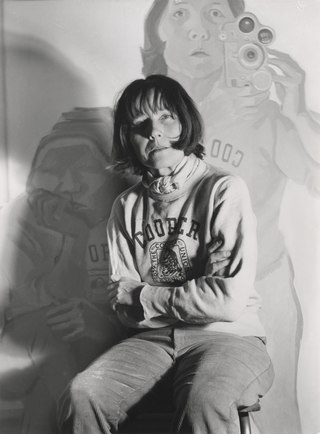
Maria Lassnig was an Austrian artist known for her painted self-portraits and her theory of "body awareness". She was the first female artist to win the Grand Austrian State Prize in 1988 and was awarded the Austrian Decoration for Science and Art in 2005. Lassnig lived and taught in Vienna from 1980 until her death.

Eggenberg Palace in Graz, is the most significant Baroque palace complex in the Austrian province of Styria. With its preserved accouterments, the extensive scenic gardens, as well as some special collections from the Universalmuseum Joanneum housed in the palace and surrounding park, Schloss Eggenberg ranks among the most valuable cultural treasures of Austria. Eggenberg Palace is situated at an elevation of 381 meters on the Western edge of the city. Its architectural design and the still visible imprint of centuries of history continue to bear witness to the vicissitude and patronage of the one-time mightiest dynasty in Styria, the House of Eggenberg.

Pedro Cabrita Reis is one of the foremost visual artists of his generation and also one of Portugal’s most internationally renowned artists. His work features a wide variety of media – painting, sculpture, photography and drawing – and has been exhibited and included in numerous national and international museum collections. He lives and works in Lisbon.

The Kunsthaus Bregenz (KUB) presents temporary exhibitions of international contemporary art in Bregenz, Vorarlberg (Austria).

Peter Pakesch is an Austrian exhibition curator, museum director and foundation director of the Maria Lassnig Foundation.
Nieto Sobejano Arquitectos is an architecture firm, founded in 1984 by Fuensanta Nieto and Enrique Sobejano with offices in Madrid and, since 2007, in Berlin.
Volker Giencke in Wolfsberg is an Austrian architect.
Frantiček Klossner is a Swiss artist based in Bern, known for creating video art, installations, performance, drawings and visual poetry.
Norbertine von Bresslern-Roth was an Austrian painter and printmaker.
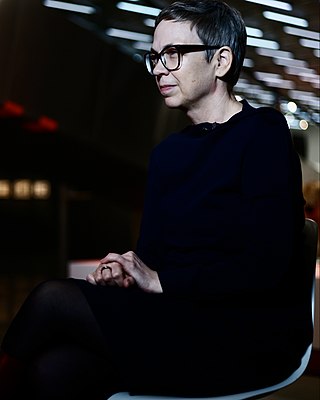
Barbara Steiner is an Austrian art historian, curator, author, and editor. Steiner is the director of the Bauhaus Dessau Foundation. She served as the director of the Leipzig Museum of Contemporary Art from 2001 to 2011, and as the director of Kunsthaus Graz from 2016 to 2021.
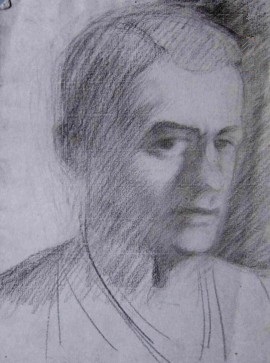
Georg Paul Schad, known as Paul Schad-Rossa was a German painter and sculptor, in the Symbolist style.

The Eiserne Haus is a building in the Lend district of Graz, Austria. It was built in 1848, and is unusual in having a cast iron frame. It is now part of Kunsthaus Graz, a cultural centre.

Aldo Giannotti is an Italian-Austrian artist. A native of Genoa, has grown up in Massa, Tuscany. He lives and work in Vienna since 2000.
